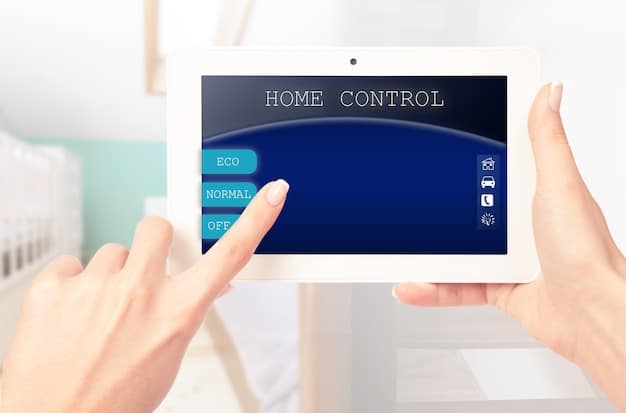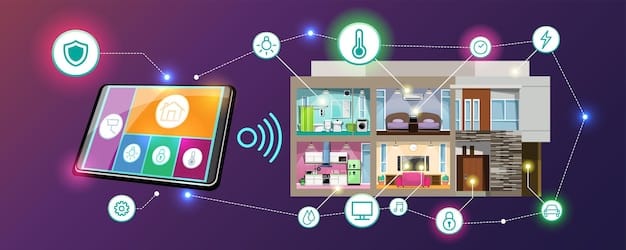Secure Your Future: Smart Home Security Tech for 2025

Smart home security has evolved beyond simple alarms, now incorporating AI, biometrics, and interconnected devices to offer comprehensive protection for families and properties.
In today’s interconnected world, ensuring the safety and security of your family and property is more critical than ever. The rise of smart home technology offers innovative solutions to safeguard your home, providing peace of mind and enhanced protection. This article dives into the latest advancements in smart home security, exploring the cutting-edge technologies that can transform your home into a fortress.
Understanding the Evolution of Smart Home Security
Smart home security has come a long way from traditional alarm systems. Today’s technology integrates seamlessly with various devices to create a comprehensive security network, offering real-time monitoring and remote control.
This evolution is driven by advancements in internet of things (IoT), artificial intelligence (AI), and cloud computing, making it easier than ever to protect your home and loved ones.
The Shift from Traditional to Smart Security Systems
Traditional security systems relied on wired connections and basic sensors. Smart systems, on the other hand, leverage wireless technology and sophisticated sensors to detect threats and alert homeowners.
The integration of mobile apps allows for remote monitoring, control, and real-time notifications, providing a level of convenience and security that traditional systems simply can’t match.
- Enhanced Monitoring Capabilities: Smart systems offer 24/7 monitoring through cameras, motion sensors, and environmental sensors, providing complete coverage of your property.
- Remote Access and Control: Homeowners can arm or disarm their security systems, view live video feeds, and control smart locks from anywhere in the world using their smartphones.
- Customizable Security Settings: Smart systems allow for personalized security settings, such as setting specific alerts for different types of events or creating automated routines based on your daily schedule.
In conclusion, smart home security provides a more flexible, convenient, and comprehensive approach to protecting your home and family compared to traditional systems.

Key Components of a Smart Home Security System
A smart home security system consists of several interconnected components working together to provide comprehensive protection. Understanding these components is essential for building an effective security setup.
These components range from smart locks and cameras to sensors and control panels, each playing a crucial role in safeguarding your home.
Smart Locks and Access Control
Smart locks provide keyless entry to your home, eliminating the risk of lost or stolen keys. They can be controlled remotely and integrated with other smart devices for enhanced security.
Features like temporary access codes and activity logs add an extra layer of security, allowing you to monitor who enters and exits your home.
Surveillance Cameras and Video Monitoring
Surveillance cameras are a crucial part of any smart home security system. They provide visual monitoring of your property, deterring intruders and capturing evidence in case of a break-in.
Cameras can be placed both indoors and outdoors, offering 24/7 surveillance and real-time video feeds accessible from your smartphone.
- Indoor Cameras: Monitor your home’s interior, keeping an eye on children, pets, or elderly family members.
- Outdoor Cameras: Deter burglars and capture footage of suspicious activity around your property.
- Video Doorbells: See and speak to visitors at your door, even when you’re not home, enhancing both security and convenience.
Smart locks, surveillance cameras, and video monitoring tools work in tandem to provide robust access control and visual surveillance, ensuring your home is well-protected.
Advanced Sensors and Detection Technologies
Beyond cameras and locks, advanced sensors play a vital role in detecting potential threats. These sensors monitor various aspects of your home environment, providing early warnings of potential problems.
From motion detectors to environmental sensors, these technologies add an extra layer of protection, alerting you to potential dangers before they escalate.
Motion Detectors and Perimeter Security
Motion detectors are designed to detect movement within a specific area, triggering an alarm or sending a notification to your smartphone. They are commonly used to protect entry points and high-traffic areas.
Perimeter security systems use sensors to detect breaches in your property’s boundaries, such as fences or gates, providing an early warning of potential intruders.
Environmental Sensors: Detecting Smoke, Carbon Monoxide, and Leaks
Environmental sensors monitor your home for potential hazards like smoke, carbon monoxide, and water leaks. These sensors can detect these issues early, giving you time to respond and prevent damage.
Smart smoke detectors can send notifications to your smartphone, even when you’re not home, while leak detectors can alert you to potential water damage before it becomes a major problem.
- Early Detection: Environmental sensors provide early warnings of potential hazards, allowing you to take action before they escalate.
- Remote Monitoring: Receive notifications on your smartphone, even when you’re not home, ensuring you’re always aware of potential problems.
- Integration with Smart Systems: Environmental sensors can be integrated with other smart devices, such as automatically shutting off the water supply when a leak is detected.
In summary, advanced sensors and detection technologies provide a comprehensive approach to home security, protecting you and your family from a wide range of potential threats.

The Role of AI and Machine Learning in Smart Security
Artificial intelligence (AI) and machine learning (ML) are revolutionizing smart home security, enabling systems to learn, adapt, and respond more effectively to potential threats.
These technologies enhance the accuracy and efficiency of security systems, reducing false alarms and providing more intelligent protection.
Facial Recognition and Biometric Authentication
Facial recognition technology can identify individuals based on their facial features, providing an added layer of security for your home. It can be used to grant access to authorized individuals and deny entry to intruders.
Biometric authentication methods, such as fingerprint scanning and voice recognition, offer secure and convenient ways to verify your identity and control access to your home.
Predictive Security Analytics and Threat Detection
Predictive security analytics use machine learning algorithms to analyze data from various sensors and cameras, identifying patterns and anomalies that may indicate a potential threat.
These analytics can detect suspicious activity, such as unusual movements or sounds, and alert you to potential dangers before they escalate.
- Improved Accuracy: AI and ML algorithms reduce false alarms by accurately identifying potential threats and distinguishing them from normal activity.
- Real-Time Threat Detection: Predictive analytics can detect suspicious activity in real-time, allowing you to respond quickly and prevent potential incidents.
- Personalized Security: AI-powered systems can learn your routines and preferences, providing personalized security settings tailored to your specific needs.
AI and machine learning are transforming smart home security, making it more intelligent, accurate, and effective at protecting your home and family.
Integrating Smart Security with Other Smart Home Devices
One of the key advantages of smart home security is its ability to integrate with other smart home devices, creating a seamless and interconnected ecosystem.
This integration enhances the convenience and effectiveness of your security system, allowing you to control and automate various aspects of your home.
Voice Assistants and Home Automation
Voice assistants like Amazon Alexa and Google Assistant can be integrated with your smart security system, allowing you to control your devices with voice commands. You can arm or disarm your system, lock your doors, and view camera feeds using simple voice commands.
Home automation systems can be programmed to automate various tasks based on security events, such as turning on lights when motion is detected or automatically locking doors when you leave the house.
Creating a Unified Smart Home Ecosystem
Integrating your security system with other smart home devices allows you to create a unified ecosystem that enhances both security and convenience. For example, you can program your smart lights to turn on when your security system detects a break-in, deterring intruders and alerting neighbors.
You can also integrate your security system with your smart thermostat, automatically adjusting the temperature when you’re away from home to save energy.
- Enhanced Convenience: Control your security system and other smart devices with voice commands or through a single mobile app.
- Automated Security: Program your system to automatically respond to security events, such as turning on lights or locking doors.
- Energy Efficiency: Integrate your security system with your smart thermostat to save energy when you’re away from home.
By integrating smart security with other smart home devices, you can create a seamless and interconnected ecosystem that enhances your security, convenience, and energy efficiency.
Best Practices for Setting Up and Maintaining a Smart Home Security System
Setting up and maintaining a smart home security system requires careful planning and attention to detail. Following best practices can ensure your system is effective and reliable.
From choosing the right devices to securing your network, these tips can help you create a robust and secure smart home environment.
Choosing the Right Devices and System for Your Needs
Before purchasing any smart security devices, assess your specific needs and requirements. Consider the size of your home, the number of entry points, and any specific security concerns you may have.
Choose a system that offers the features and functionality you need, such as 24/7 monitoring, remote access, and integration with other smart home devices.
Securing Your Network and Protecting Your Data
One of the most important aspects of smart home security is securing your network. Use a strong password for your Wi-Fi network and enable encryption to prevent unauthorized access.
Regularly update your devices’ firmware to patch any security vulnerabilities. Consider using a virtual private network (VPN) to encrypt your internet traffic and protect your data from hackers.
- Strong Passwords: Use strong, unique passwords for all your smart home devices and accounts.
- Regular Updates: Keep your devices’ firmware up to date to patch any security vulnerabilities.
- Secure Network: Use a strong password for your Wi-Fi network and enable encryption to prevent unauthorized access.
By following these best practices, you can ensure your smart home security system is effective and reliable, protecting your home and family from potential threats.
| Key Point | Brief Description |
|---|---|
| 🏠 Smart Locks | Keyless entry with remote control and temporary access codes. |
| 📹 Surveillance Cameras | 24/7 monitoring with real-time video feeds accessible remotely. |
| 🚨 Motion Detectors | Detect movement, triggering alarms and notifications. |
| 🤖 AI Integration | AI enhances threat detection and reduces false alarms. |
FAQ: Smart Home Security
▼
Smart home security systems offer enhanced monitoring, remote access, and customizable settings, providing a more flexible and comprehensive approach to protecting your home and family.
▼
Smart locks eliminate the risk of lost or stolen keys, offering keyless entry with remote control and temporary access codes, adding an extra layer of security.
▼
Surveillance cameras provide visual monitoring of your property, deterring intruders and capturing evidence in case of a break-in, enhancing overall security.
▼
AI and ML algorithms reduce false alarms and provide more intelligent protection by accurately identifying potential threats and distinguishing them from normal activity.
▼
Use strong passwords, regularly update device firmware, and consider using a VPN to encrypt your internet traffic and protect your data from hackers, ensuring a secure network.
Conclusion
As technology continues to advance, smart home security systems will undoubtedly become even more sophisticated and integrated into our daily lives. By embracing these innovations and following best practices, you can create a secure and protected environment for your family and property, ensuring peace of mind in an increasingly connected world.





